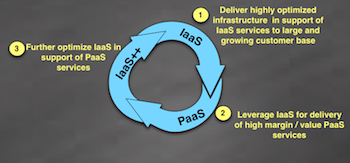
But no sooner had the market acknowledged the success of IaaS, than Amazon shifted the playing field. With the introduction in the last few years of services like RedShift, CloudSearch, Elastic Map Reduce, AppStream, and Kinesis, Amazon has built up a portfolio that positions it competitively in the PaaS game. The portfolio is sufficiently rich now that with their JavaScript API and identity federation, you can build sophisticated server-less applications.
There are of course many reasons to think Amazon could be much more successful in PaaS than their predecessors. By delivering IaaS to an early adopter market that wanted consumption-based pricing of storage, network and compute, they have grown a nascent business to one that is estimated at $4B+ in annual revenue. The established and rapidly growing customer base provides them a clear target market for their PaaS services, deep experience in customer workloads, and a high optimized / reliable infrastructure to support their platform offerings.
But there is one technical difference between Amazon’s platform services that should worry every other cloud provider: AWS has built its PaaS directly upon its IaaS.
Yes, I know that seems like an obvious way to build platform services in 2013. But you only need to look around to realize this is surprisingly uncommon (e.g. Microsoft Office 365, IBM SmartCloud Object Storage). While Amazon does not publicly discuss its service implementations (Wizard of Oz: “Pay no attention to the man behind the machine”), with some basic sleuthing, it is clear this is the the case (e.g. historical outage reports, AWS resource bill).
What this means is Amazon has established the first closed loop virtuous cycle for building a full stack of cloud infrastructure and services. AWS is leveraging their optimized infrastructure to deliver IaaS services (e.g. EC2, EBS) to a rapidly growing customer, then using this same IaaS infrastructure to develop and deliver higher level / higher margin platform services (e.g. Kinesis, AppStream), which in turn are driving additional innovation back into the IaaS services (e.g. C3 and I2 instance type families).
The cloud game is not over by any means. But in the two decade march toward cloud computing's total transformation of our technical landscape, one cloud vendor seems to be rapidly approaching cloud escape velocity.
